Menu
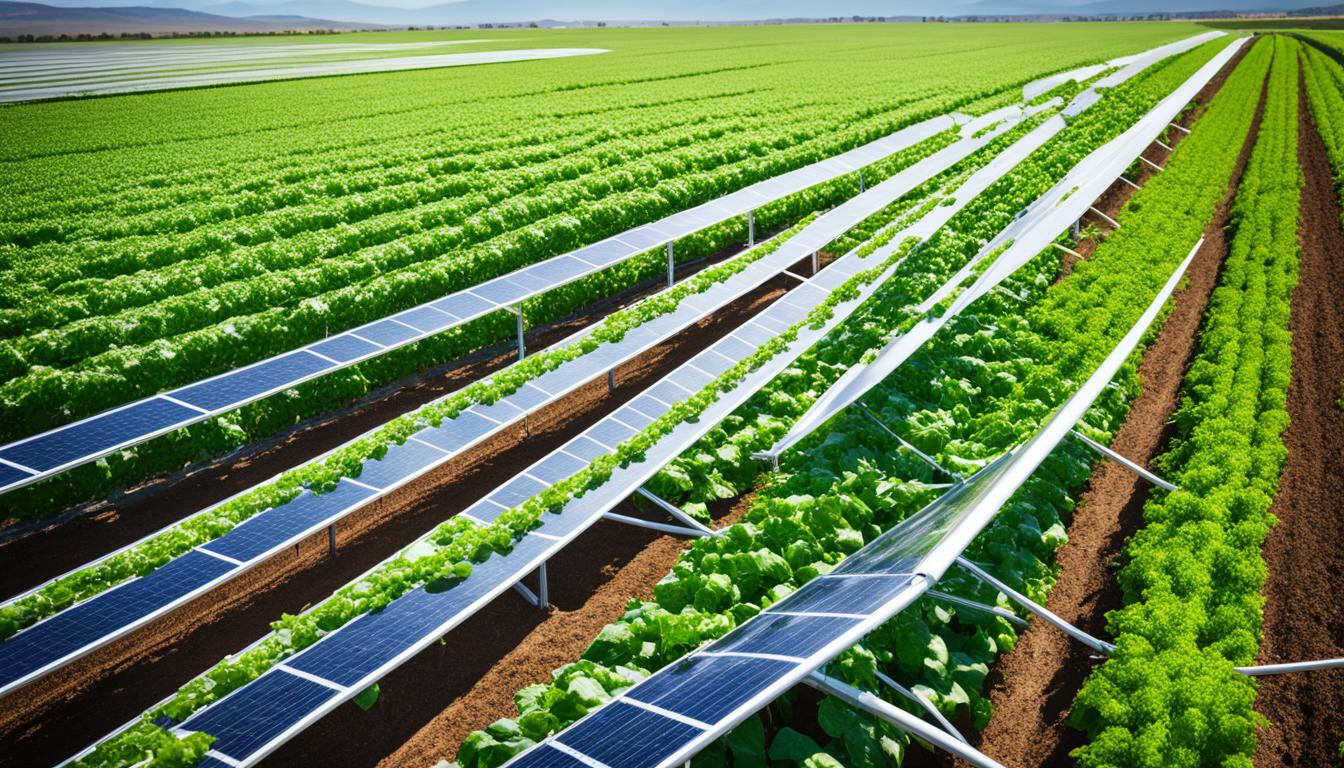
Every year, 12 million hectares of farmland are lost to drought and desertification. This shows the need for sustainable farming solutions. Climate change and the loss of natural resources threaten our food supply. So, using green farming technology is vital.
In recent years, farming has changed a lot because of new technology. Farms now use things like robots and smart sensors. These help make farming more profitable and better for the environment. ADM’s projects have already helped over 44,000 farmers worldwide with sustainable agriculture.
Modern tools allow for precise farming by using resources wisely. They reduce waste and protect the environment. For example, Bihar, India, loses $1.7 billion of crops each year. This is because they don’t have the right technologies. It shows how important sustainable farming equipment is.
The world of farming is evolving with sustainable farming technology. This change brings methods that use less water, fertilisers, and pesticides. These customised approaches improve crop yields, lower costs, and help the environment.
Sustainable farming tech has many upsides. It helps the environment, keeps food safe, and protects workers. For example, vertical farming with the help of AI uses far less water and land. This shows the power of green agri-tech.
The move towards alternative proteins is also growing fast. By 2035, this market could be worth over $290 billion. Plant-based and lab-grown meats need fewer resources, produce less greenhouse gas, and use less land and water.
In the past, farming mainly used lots of water and chemicals. This caused problems for the environment. But, the use of digital tech in farming is bringing big changes. Now, over 65,000 startups are leading the way in farm technology. This means the future of farming looks bright.
Moving to precision farming is a big change in how we farm. Making plant-based burgers over beef can save a lot of land and water. It also cuts down on greenhouse gas emissions. Technologies like shear-cell are making plant-based meats better for the planet and in higher demand.
| Comparative Factor | Traditional Farming | Vertical Farming with AI and Robotics |
|---|---|---|
| Water Usage | 100% | 5% |
| Land Usage | 100% | 5% |
| Fertiliser Usage | 100% | 5% |
| Greenhouse Gas Emissions | 100% | 10% |
Sensor technologies have changed farming deeply. They help us watch and run farms better. These tools are part of smart farming, giving us live updates on the land, the plants, and even the animals.
Today, agriculture uses many sensors. There are special cameras that fly above farms, checking how plants are growing. They spot issues like sickness early.
Weather sensors are also big help. They tell us what the weather’s like. This helps farmers decide when to plant or harvest.
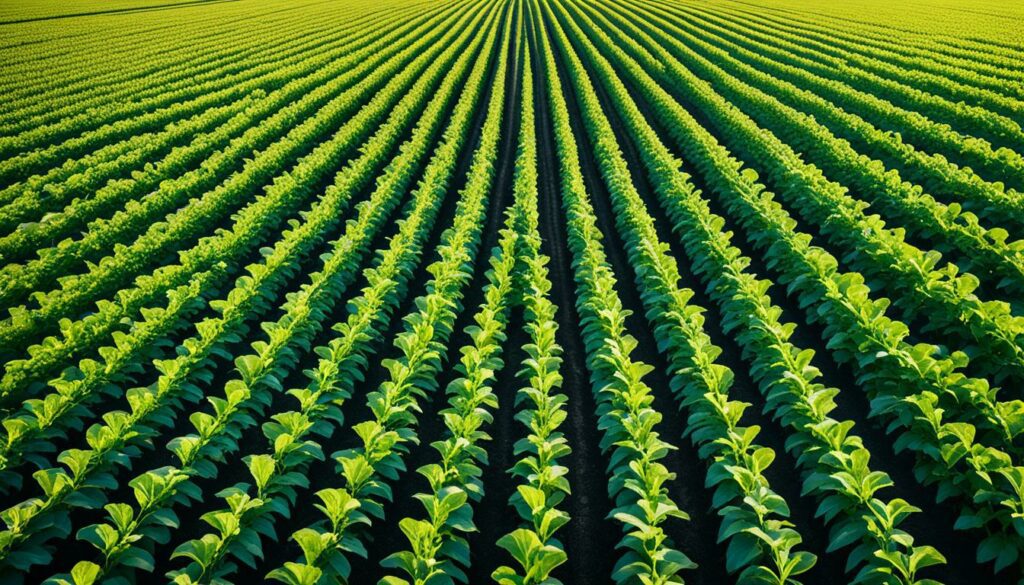
Other sensors check how wet the soil is and if it’s good for plants. There are also gadgets to see if the air and light are right for crops. All this helps farmers grow healthier crops.
This new tech has made farming smarter. Farmers get quick, accurate info to make better choices. For example, sensors can turn on and off water for plants, using less and saving money.
Drones are now eyeing the fields too. They show farmers where they need to work more. They can spot sickness in plants and bad weeds.
Sensors are not just for plants. They also keep an eye on the animals. There are devices tracking cows to make sure they’re well.
Technology also follows farm equipment, showing where it is and how it’s doing. This helps farms run smoother and do a better job with animals.
To wrap up, sensors are making farming much more accurate and efficient. They cover everything from the sky to the ground, helping farmers grow better while taking care of the land and the animals.
Smart irrigation systems have changed how we manage water in farming. They use new tech and real-time data to save water. This helps make farming both more efficient and better for the planet.
Smart irrigation systems save water by controlling it closely. Normally, a lot of water in farming is wasted. But with smart systems, water use is more efficient. This saves money and helps crops grow better. They also make farming easier by showing farmers the best way to water fields. This keeps the land healthier over time.
Smart systems use IoT sensors, AI, and detailed maps. IoT sensors keep track of soil, the weather, and how water is used. This info helps make smart choices about when to water. It also stops too much or too little water from being used. AI helps by automatically running the system, which makes farming smarter and more efficient.
Different irrigation methods, like flood or drip systems, can use these new techs. This is especially useful in dry places like parts of Africa and Asia. Detailed maps help save money by showing exactly where the water should go. As the world’s population grows, we’ll need our farmland to work even better. So using water wisely in farming is crucial for our future.
Robotics in farming have changed how we work the land. They use high-tech tools to improve how we grow our food. Now, we can plant, weed, and harvest more accurately. This makes farm work better and helps the Earth. By using these machines, we’re looking after our planet for the future.
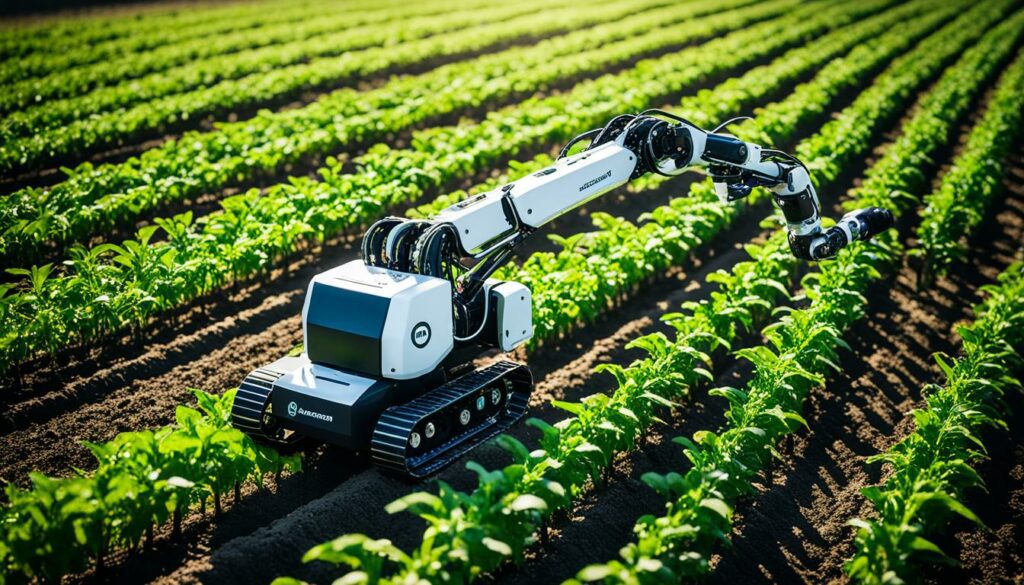
Robotic planting and weeding are making a big difference. They tackle heavy tasks, saving time and money. With machines like autonomous tractors, farming is becoming more efficient. Each plant gets only what it needs, which is good for the Earth.
Harvesting is getting a lot faster with robotics. These machines can pick crops quicker than people. They’re helping us keep up with the demand for food. By 2028, the market for these farming robots could be worth USD 40.1 billion.
Sure, the upfront cost of these tools is high. But, they pay off over time. They save money, use less resources, and help protect the planet. As technology gets better, so will farming. Robotics and AI promise a bright future for agriculture.
In the last few years, drone technology has leaped forward. Today, it’s key to modern farming. Drones use sensors and cameras to give a bird’s eye view of crops. This view helps farmers to do precision farming, making their work more eco-friendly.
Agri-drones come with many types of cameras and sensors. They can have simple cameras, multispectral sensors, infrared cameras, and thermal cameras. Each one tells us something different:
Using drones is more than just about pictures. They are great for managing crops too:
The future of using drones in farming is bright. They’re getting more useful as they evolve. For example, the ZenaDrone 1000 helps plant responsibly, avoiding big machines. It can also take on tough weather, making it a reliable green farming tool.
Drones have a lot of potential in farming. They’re quick to catch on and cut down on planting costs. This shows how they’re changing farming for the better, making it more eco-conscious.
| Application | Benefits |
|---|---|
| Aerial Imagery | Efficient crop monitoring, early problem detection |
| Aerial Spraying | Faster application, reduced labour costs |
| Soil Analysis | 3-D mapping, better resource allocation |
| Irrigation Improvements | Targeted irrigation, reduced water waste |
In our pursuit for better farming, biotechnology has made a big difference. By using biotech in agriculture, we’ve seen big jumps in how we grow crops and fight diseases. This has helped meet the needs of more people without harming the Earth.
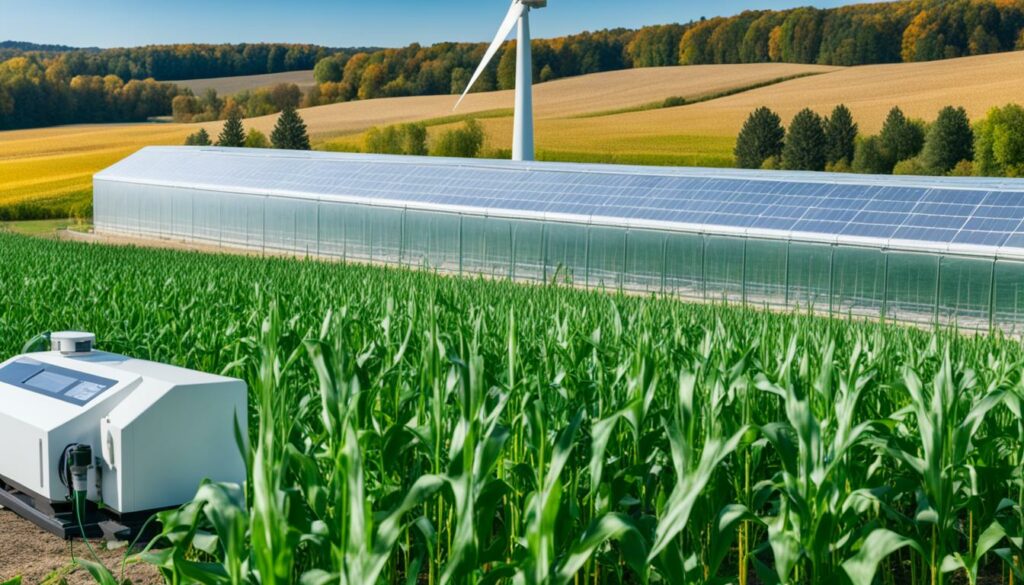
By using biotechnology, crop breeding has got a lot better. It has helped crops grow more, even though our usual ways were falling short. For example, some engineered crops can withstand a weed killer, which means we use less harmful chemicals. This is a big plus for the environment.
The US Department of Agriculture reports that many farmers are now using engineered crops. In fact, by 2012, over 88% of corn, 94% of cotton, and 93% of soybeans were from biotech. This shows how key biotechnology is in today’s farming.
CRISPR is a cutting-edge tool in agriculture biotechnology. It lets us change crops to be tough against the weather, use water better, and grow more food. We have seen that these changes can boost the health of the food we grow and help fight weeds.
This tool also helps make crops that bugs don’t like or that tolerate weed killers better. As a result, we use fewer harmful chemicals. For farmers, this means better crops and easier ways to grow them, while being kinder to the environment.
| Crop | Current Yield Growth Rate | Required Yield Growth Rate |
|---|---|---|
| Maize | 1.6% per year | 2.4% per year |
| Rice | 1.0% per year | 2.4% per year |
| Wheat | 0.9% per year | 2.4% per year |
| Soybean | 1.3% per year | 2.4% per year |
Biotechnology is changing how we farm for the better, and it’s not stopping. CRISPR and farm tools that are good for the planet play a critical role. They help ensure we have enough food, keep our planet healthy, and support everyone living here.
Smart farming changed how we farm. It combines data analytics and AI to make farming more efficient and kind to our planet. By using IoT sensors, weather predictions, and past data, we learn how to manage farms better.
AI is transforming farming, making it smarter. It looks at lots of data from tools like yield mapping, soil mapping, and auto-guidance machinery to use resources better. With AI, farmers can wisely choose how to use water and fertilisers, saving money — up to $25 per acre, says a 2016 USDA study.
This tech also cuts down on how much energy we use and the gases we put out, all by making our machines work more accurately.
Big data helps make farming sustainable and efficient. It’s all about keeping an eye on soil health, stopping erosion, and making the soil better over time. Also, it lets us fight pests without heavy use of chemicals, promoting the use of natural pest control.
But, starting up with these technologies can cost a lot. Plus, there’s the challenge of getting good internet in rural areas and keeping data safe. Dealing with these things needs everyone to work together. This teamwork helps make sure farming helps feed the world and protects our planet.
Using GIS and GPS in farming has changed the game for modern farms. These tools make field maps more accurately and help use resources better. This leads to farming smarter.
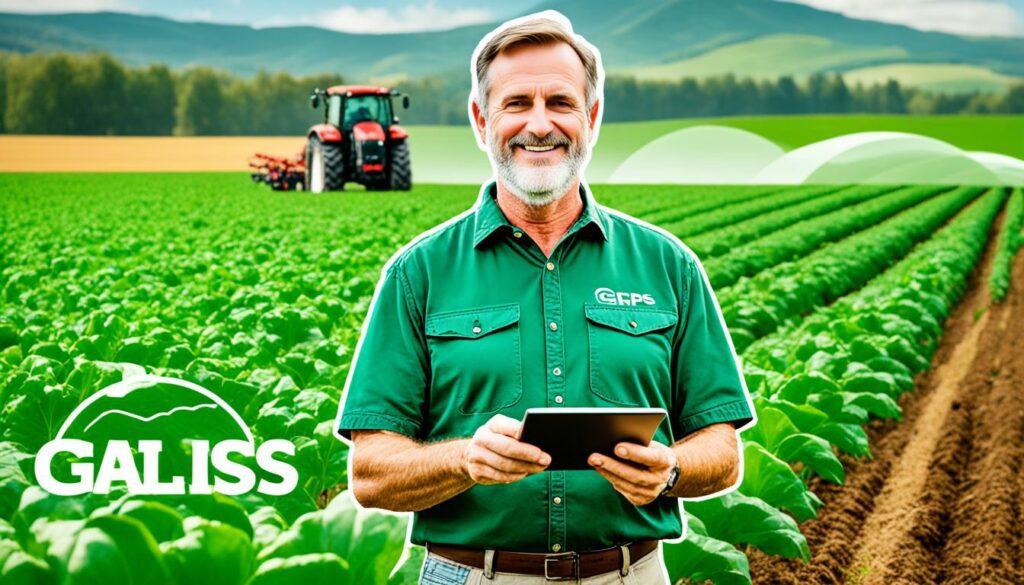
GIS creates detailed farm maps. They are key for many farm tasks. These tools are so precise that they can get within 10 centimetres. This is needed for things like putting seeds in the right spot or adding fertiliser.
With drones using RTK, tasks that usually take days can be done in 30 minutes. This gives farmers quick and very accurate information.
GIS and GPS are essential for using farm resources well. With tools like VRT, farmers can apply things like seeds and water exactly where they need to. This boosts production and cuts down on waste.
For example, these new farming methods have upped production by 4%. They also cut down on things like fertiliser and fuel use.
Plus, these technologies are becoming more affordable. For instance, Point One Polaris’s RTK technology costs only $50 a month. So, even smaller farms can use these tools to improve their operations.
Eco-friendly agrotech solutions are changing how we farm. They help us do more with less harm to our planet. By using less chemicals and smarter pest control, modern farms can be friendly to nature and still grow plenty of food.
Agrotech Plus leads the way in farming that’s good for the earth. We’ve found ways to use fewer chemicals without losing the goodness in the crops. This change is not only good for our health but it’s also vital for the planet’s future.
Our approach includes using nature to fight pests. It means less need for chemical sprays. This way, we not only keep good insects alive, but we also keep the environment in balance. It’s a win for the planet and for farming.
| Agrotech Plus Initiatives | Benefits |
|---|---|
| Reduction of Chemical Usage | Minimises environmental impact and improves food safety |
| Integrated Pest Management | Fosters natural pest control and maintains ecological balance |
| Climate-Resilient Food Production | Ensures food security amidst changing environmental conditions |
| Adoption of Green Energy | Reduces carbon emissions and promotes sustainability |
| Support and Training for Farmers | Empowers farmers with sustainable farming solutions for enhanced productivity |
Using eco-friendly tech in farming helps us all. It makes our food better and our world healthier. We’re working for a future where farming works with nature. This way, we can overcome the challenges we face today and tomorrow.
The world of farming is changing fast. It’s moving towards tools that protect the environment. New farming machines use the latest tech to work better and help the planet. They are designed to use less energy and help farmers do good for the earth.
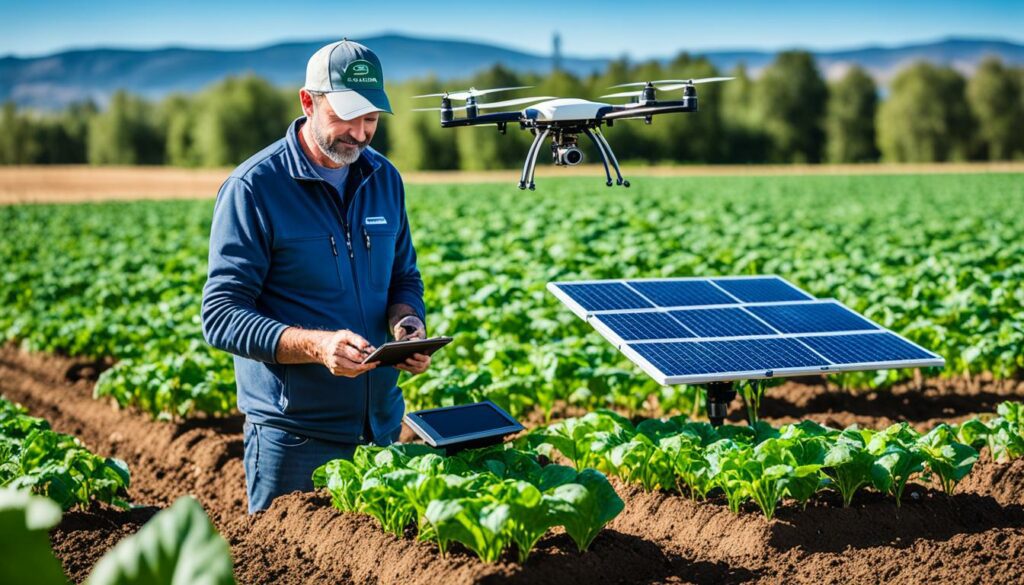
New farming machines are a game changer. They use AI and robots to grow crops without using much water or land. This helps the earth a lot. These methods are more about using technology to make food in a smart way.
There’s also new machines making plant-based foods. They are good for the earth because they use way less water, land, and energy than making meat. In fact, machines that make plant-based burgers save a lot of energy and reduce pollution by a large amount.
Farmers are also seeing big changes in how safe and easy their jobs are. New machines are very smart. They use special sensors and data to work better. This means less mistakes and safer work for the farmers.
Many jobs that were tough for workers can now be done by machines. This makes work easier for people. They can do more important things on the farm. Plus, these changes are good for nature as they use less energy and keep the environment safe.
| Aspect | Traditional Methods | Innovative Machinery |
|---|---|---|
| Water Usage | 100% | 5% |
| Land Usage | 100% | 7% |
| Energy Usage | 100% | 54% |
| Greenhouse Gas Emissions | 100% | 10% |
Green agriculture practices are important for the future of our farms. They aim to use fewer artificial inputs. Instead, they work to keep the land healthy.
Organic farming is a key part of green agriculture. It avoids synthetic chemicals and GMOs. By using natural ways like compost and manure, soil health is kept.
In fact, the United Nations states that switching to these methods is critical. This is because we will need 70% more food by 2050.
Crop rotations are also crucial in green agriculture. They stop soil from getting tired and keep pests away. This keeps the soil rich and helps crops grow well.
For example, vertical farming is very cutting-edge and efficient. It can grow more food using less water. In the U.S., vertical farms are growing thousands of kinds of food like lettuce and berries. Plus, practices like Bee Vectoring Technologies help cut down on harmful chemicals in farming. This means organic and sustainable farming is very important today.
Farming technology has improved a lot, bringing exciting promises for the future. But, there are several hurdles in using sustainable technology fully.
Sustainable farming requires a lot of money to start. This is a big problem, especially for small and medium farms. The OECD has studied this and found it to be a major issue in many countries.
Dealing with this needs new ways to fund projects and help from the government.
Many rural areas lack good internet and phone connections. This is a big issue for using sustainable technology properly. In a 2000 meeting at Wageningen, it was clear that this is a big roadblock.
Improving rural connectivity is key to making technology more available in these places.
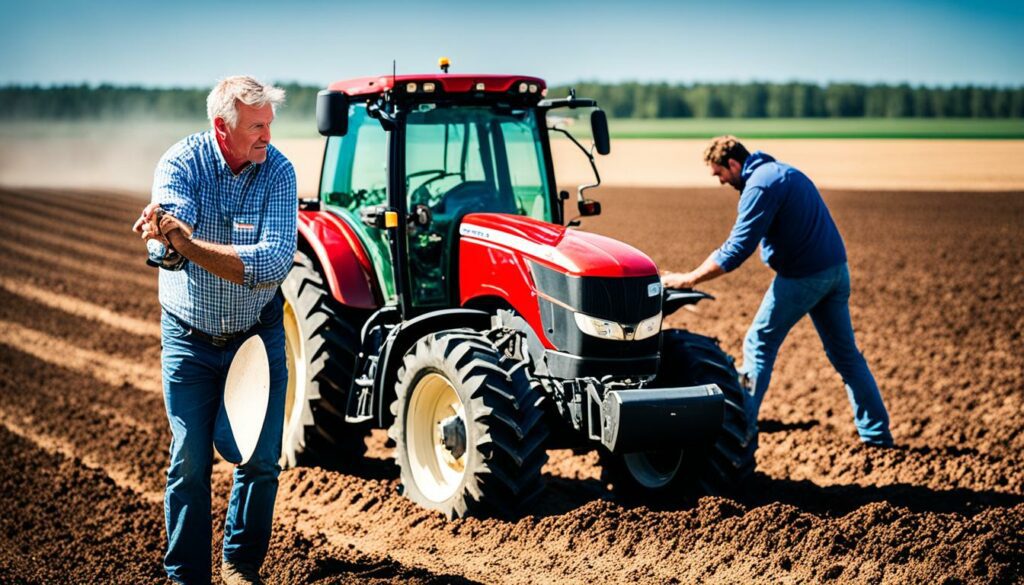
| OECD Member Countries | Joined Year |
|---|---|
| Original Members | 1960-1961 |
| Japan | 1964 |
| Finland | 1969 |
| Australia | 1971 |
| New Zealand | 1973 |
| Mexico | 1994 |
| Czech Republic | 1995 |
| Hungary | 1996 |
| Poland | 1996 |
| Korea | 1996 |
| Slovak Republic | 2000 |
These big issues need to be faced to use sustainable farming tech well. This is important for making our farms greener and more successful in the future.
Government and institutional support are key in pushing forward sustainable farming. In the European Union, subsidies help deal with issues like job keeping and sustainability. But, the Common Agricultural Policy (CAP) has been criticised for using resources wrongly, needing change to work better.
China’s government, for example, is enhancing its agricultural environmental policies. This shows a global trend where big countries support their agriculture more. This support helps companies be more innovative and reduce their impact on the environment.
It’s important to note that not all countries support eco farming in the same way. We need to understand these differences better, especially their effects on rural areas. In the United States, funds from the U.S. Department of Agriculture help the Sustainable Agriculture Research and Education (SARE) programme support farmers since 1988.
The National Institute of Food and Agriculture (NIFA) also plays a big part, investing $380 million over ten years in many projects. SARE’s work covers many topics like renewable energy and crop management. These efforts help every U.S. state and island get greener, thanks to strong support from institutions.
Sustainable farming tech boosts crops, cuts harm to nature, and makes jobs safer. It uses tools like sensors, robots, and biotech. These tools make farming kinder to the earth while saving resources.
Agriculture has moved from old ways to precise methods in the past years. Things like ICT, sensors, drones, and robots help use water, fertilisers, and pesticides better. This helps the farmer and the planet.
Today’s farming uses many sensors. Think temperature and moisture sensors, and more. These sensors give exact data for smart farming decisions.
Smart irrigation helps save water and improves crops. It lets farmers control water and nutrients precisely. This means less waste and better plants.
Robots can plant, weed, and harvest. They cut down on work, make farms safer, and lower costs. This helps farms use fewer resources and be more sustainable.
Drones watch over crops and help farmers plan better. They take many kinds of pictures to check on plants. This makes growing food more efficient.
Biotech creates plants that grow better with less water and fight bugs. This helps feed more people without hurting the planet too much.
AI and big data use lots of info to make farm decisions smart. They help farmers use resources well and meet green goals.
GIS and GPS draw maps and manage resources precisely. This means planting and using things on the farm better. It makes farming more productive and eco-friendly.
To cut chemicals, farmers use natural ways to fight pests. This keeps the farm’s balance healthy without chemicals. It still grows lots of food.
Better tools make farming safer and more precise. They lower risks and help farms work better. This is good for the earth and the people working the land.
Green farming is about using natural methods and rotating crops. This keeps the soil good, stops erosion, and helps wildlife thrive. It’s how farms can last for years to come.
The cost and getting good internet in rural areas are hard. But, it’s key to overcome these to have farming that’s good for the planet.
Governments and groups can help by giving perks, doing research, and building things for farmers. This support keeps farming green and uses the best new tech.